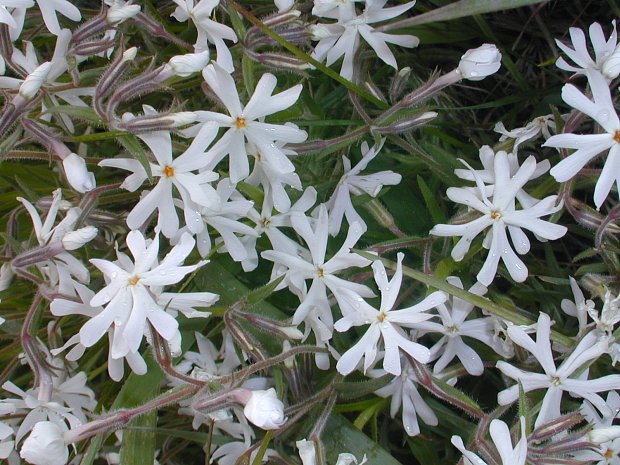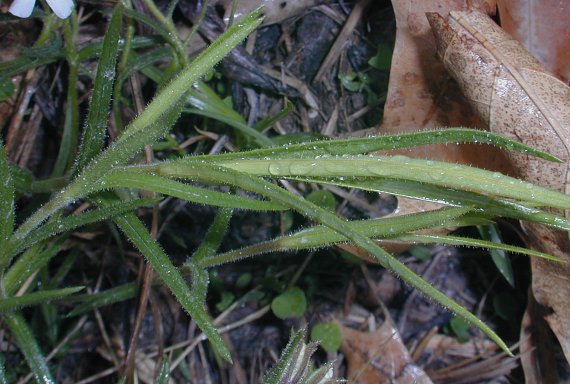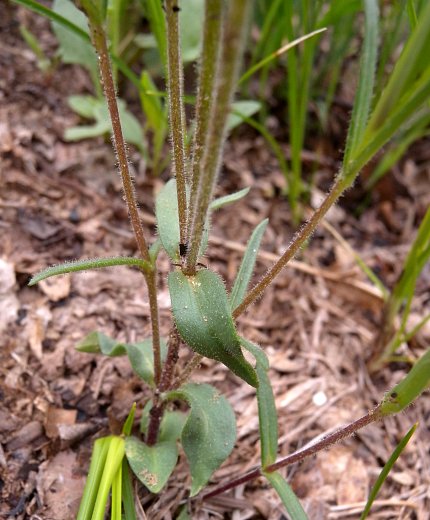Description: This herbaceous perennial plant is about 1' tall. Multiple stems often develop from the crown of the taproot, and each stem occasionally branches. The stems are somewhat woody at the base and have a tendency to sprawl; they are usually covered with both glandular and non-glandular hairs. Pairs of opposite leaves occur at intervals along each stem. These leaves are up to 2" long and ¼" across; they are linear to linear-lanceolate, smooth along the margins, and glabrous to hairy. The base of each leaf is sessile or slightly clasps the stem. The upper stems terminate in small cymes of about 3 flowers; less often, individual flowers may develop from the axils of the upper leaves.

The slender pedicels of the flowers are up to 1" long and covered with hairs, like the stems; they are often reddish green. Each flower is about ¾" across, consisting of a tubular calyx with linear teeth and a a tubular corolla with 5 spreading lobes. The calyx is green or reddish green and covered with hairs. The corolla is white or pale blue-violet; the opening at its throat is quite small. The petal-like lobes are narrow and cleft at their tips to about one-half of their length. The blooming period occurs from mid-spring to early summer and lasts about 1½ months. Each flower is replaced by an oblongoid seed capsule that is 3-celled and contains several small seeds. The root system consists of a taproot. This plant spreads by reseeding itself and may form colonies at favorable sites.

Cultivation:
The preference is full or partial sun, mesic to dry conditions, and
sandy or rocky soil where there is reduced competition from other
plants. This plant adapts well to sunny slopes.
Range & Habitat:
The native Sand Phlox is occasional to locally common in sandy areas of
central
and northern Illinois, otherwise it is uncommon or absent (see Distribution
Map). Habitats include mesic to dry sand prairies, hill
prairies, sandy savannas, sandy shoulders of roads, thinly wooded
bluffs, cliffs, and limestone glades. Occasional wildfires are
beneficial in reducing competition from woody vegetation.

Faunal
Associations:
Butterflies, skippers, and moths suck nectar from the flowers. The
caterpillars of the moths Heliothis phloxiphagus
(Darker-spotted Straw) and Heliothis
turbatus (Spotted
Straw) feed on the flowers and developing seeds of phlox species (Phlox
spp.). Other insect feeders of these plants include Lopidea davisi
(Phlox Plant Bug), the aphid Abstrusomyzus
phloxae, and the stem-boring larvae of the long-horned
beetle, Oberea flavipes.
Most mammalian herbivores readily
eat the foliage of Phlox spp.
Photographic Location:
A sandy area along a road and a sandy oak savanna at the Hooper Branch
Savanna Nature Preserve in Kankakee County, Illinois, where this
plant species is locally common.

Comments: Sand Phlox has lovely flowers. The strongly cleft lobes of the flowers distinguish it from other Phlox spp. Across its range, Sand Phlox is somewhat variable in the appearance of its flowers and the hairiness of its foliage. Another subspecies of Sand Phlox, Phlox bifida stellaria, has flowers that are cleft to about one-fourth the length of their lobes. The foliage of this subspecies has only non-glandular hairs, while the typical subspecies has both glandular and non-glandular hairs. The subspecies Phlox bifida stellaria is restricted to only 1 or 2 counties in southern Illinois, where it occurs in upland rocky areas. Regardless of the subspecies, another common name for Phlox bifida is Cleft Phlox.